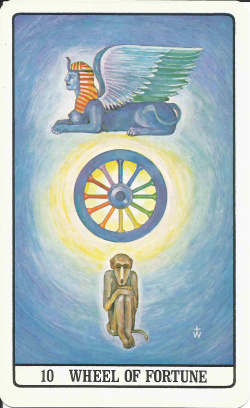Difference between revisions of "The Wheel"
m |
m (→Notes) |
||
| Line 4: | Line 4: | ||
[[File:golde-dawn-wheel.jpg|250px|right|Golden Dawn Wheel]] | [[File:golde-dawn-wheel.jpg|250px|right|Golden Dawn Wheel]] | ||
The Wheel is an archetype in the [[Masonic Tarot]] deck. The full character of The Wheel, as envisaged by the ruling classes, is provided by the Golden Dawn tarot card which shows a lordly elite (with roots/bloodline in ancient Egypt) lording it over the ape like and primitive slave. | The Wheel is an archetype in the [[Masonic Tarot]] deck. The full character of The Wheel, as envisaged by the ruling classes, is provided by the Golden Dawn tarot card which shows a lordly elite (with roots/bloodline in ancient Egypt) lording it over the ape like and primitive slave. | ||
The archetype of "accept what is." In middle-class schools we learn that "What has happened in the past and what exists now may not be equitable or fair, but (shrug) that is the: way things are, and one does not confront such matters in school."<ref>Jean Anyon, “Social Class and the Hidden Curriculum of Work,” Journal of Education 162, no. 1 (1980). p. 78</ref> | |||
==Further Reading== | ==Further Reading== | ||
Revision as of 17:26, 27 January 2019
The Wheel is a short hand phrase used in esoteric circles to refer, euphemistically, to the Regime of Accumulation to which the enslaved masses are pinned in servitude. Used in a sentence, "We are bound to The Wheel in productive servitude."
Notes
The Wheel is an archetype in the Masonic Tarot deck. The full character of The Wheel, as envisaged by the ruling classes, is provided by the Golden Dawn tarot card which shows a lordly elite (with roots/bloodline in ancient Egypt) lording it over the ape like and primitive slave.
The archetype of "accept what is." In middle-class schools we learn that "What has happened in the past and what exists now may not be equitable or fair, but (shrug) that is the: way things are, and one does not confront such matters in school."[1]
Further Reading
- ↑ Jean Anyon, “Social Class and the Hidden Curriculum of Work,” Journal of Education 162, no. 1 (1980). p. 78
